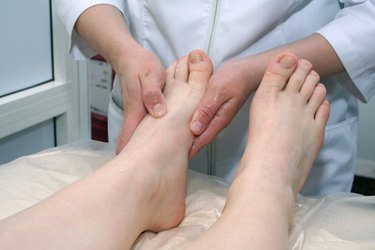
Acupressure and reflexology are two alternative complementary therapies that systematically apply pressure to certain parts of the body to reduce aches and pains. Some pressure points are also purported to improve the function of other parts of the body. Though many people find relief from these techniques, the scientific community has yet to come to a verdict on their effectiveness and validity. Alternative treatment is not a replacement for traditional care--if you are having pain in your feet or problems in areas associated with pressure points in the heels, speak to your doctor about the treatment options available.
Achilles Tendon
Video of the Day
The Achilles tendon connects the foot, ankle and calf muscles to the heel bone. Run your fingers down the back of your foot, feeling for a small strip that connects the two bones that protrude from your ankle. The thin strip of tendon is the Achilles tendon. Apply pressure to the Achilles tendon from both sides using a gentle, inward motion. Use caution when applying pressure to the Achilles tendon, it is a sensitive area that can hurt immediately if too much force is used. This pressure point is purported to improve kidney function, according to "Acupressure and Reflexology for Dummies."
Video of the Day
Back of the Heel
Run your hand along the bottom of your foot, away from the toes. The farthest point of the heel parallel with the second toe of your body is a pressure point purported to help ease lower back pain, according to Janet Wright in "Reflexology and Acupressure: Pressure Points for Healing." This pressure point is present in both feet and is said to alleviate the discomfort associated with standing for extended periods of time. Apply pressure to this spot using your finger or a dull object, such as a pencil eraser, for periods of 15 to 30 seconds.
Middle of the Heel
Imagine a parallel line running from the third toe of your foot to the part of your heel that lines up with the ankle bones that protrude from the sides of your foot. This heel pressure point is associated with the sciatic nerve, according to "Feet First: A Guide to Foot Reflexology." The sciatic nerve is the longest, widest nerve in the human body and originates in the lower back. Symptoms associated with problems deriving from the sciatic nerve, notably sciatica, spinal disc herniation and spinal stenosis, are said to be decreased when light to moderate pressure is applied to this heel pressure point.
Side of the Heel
The sides of the heel, where the top of the ankle meets the heel, is a pressure point noted in "The Reflexology Bible" to help alleviate pain in the tailbone or extreme bottom of the spine. Apply gentle pressure with an inward motion, massaging toward the big toe, for periods of 15 to 30 seconds. This pressure point is only found on the insides of the foot, the side closest to the big toe. The point is directly aligned with the middle heel pressure point linked to the sciatic nerve.
Is this an emergency? If you are experiencing serious medical symptoms, please see the National Library of Medicine’s list of signs you need emergency medical attention or call 911.